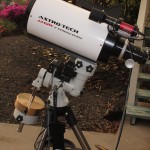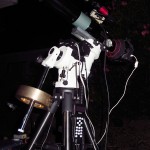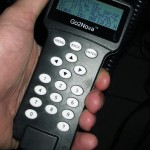I had been looking to acquire another astrophoto toy. The desire is for a small, portable astrophoto setup. Yes, I am aware that the words “portable” and “astrophoto” do not really belong in the same sentence, all things are relative.
Thus I have decided on the new iOptron ZEQ25. It is a new design, with some radical differences from the more traditional German equatorial mounts.
The mount is pretty small, a mere 10 pounds of steel and aluminum. Compact enough to be packed into a suitcase for air travel. Performance sufficient to do wide field astrophotography with focal lengths up to 1000mm and a DLSR camera. Perfect for use with either my TV-76 or AT6RC. Unlike my old Losmady G-11 it features a modern GOTO system and can be run from the computer.

I ordered the mount from the good folks at OPT. It was not yet listed in the website catalog, but a phone call confirmed they were expecting delivery of three mounts shortly. I put down my deposit. A week later I had confirmation that the mount had been received and was ready for shipment to Hawaiʻi as promised.
Anticipation quickly set in… No problem, I just have to wait a few more days… Working on the summit I get a message that a box with my name has arrived in shipping and receiving. Yes!! The mount has arrived early. On the drive back down the mountain I note the clear skies and plan an evening of playing with my new astro toy. Arriving in shipping I look at a box too small to hold the entire mount, it is only the tripod, box 1 of 2 of the shipment. No sign of box 2… Noooooo!! I must wait another day.
To my great relief the second box did arrive with the UPS truck the next day…
So did the clouds.
Under a leaden grey sky I set up the mount for the first time. It appears that the new astro gear curse is in full effect. At least I can assemble everything.

The mount can be used for any latitude from 0° to 60°. For latitudes under about 35° it is necessary to change out the adjustment knob, a sort of a bottlescrew arrangement. It only takes a few moments to swap out the knob. I will have to find a home for the longer bottlescrew to insure it does not get lost. Once latitude is adjusted a pair of locking screws, one on either side, securely lock the adjustment.

I was unable to balance the AT6RC with the supplied 10 pound (4.7kg) counterweight. At least twice the weight is needed to achieve balance with this OTA. No problem, I have some brass around somewhere to make another counterweight. In the meantime I kludged one of my Losmandy weights in place by means of a small piece of aluminum inserted under the locking screw before tightening. The kludge allowed an evening of tests.
Powering up the mount I commanded a couple manual slews. Everything moves smoothly, there is a variety of odd noise emitted by the servo motors. This mount noise will be interesting to listen to through the night. At least you know when it it tracking. Balance appears critical… I experienced a couple RA overcurrent errors early on, rebalancing seems to have solved that issue.
An hour in the shop the next day produced a heavier counterweight from some 6″ brass rod. With this the mount balances the AT6RC nicely. Another evening in the shop will be required to make a Vixen style dovetail plate for the TV-76. Now I just need some clear skies! The forecast is not encouraging. One of my oh-so-helpful friends comments that the clouds last a number of days after a purchase that is in proportion to the cost of the astro-gear in question. The ZEQ-25 isn’t that expensive!

So far I like the iOptron controller. A four line LCD provides a lot of information at a glance. No need to jump through a few menu selections to read out RA and Dec. Current mode and slew speed is always displayed. I have spent much too long trying to control the scope with a computer. Suffice it to say one should not attempt to use an old version of The Sky, but ASCOM works pretty well. I will address this issue in a later post.

At 12.9 pounds, the AT6RC appears to be about as heavy a telescope one would want to mount to the ZEQ25. The smaller, 5.1 pound TeleVue-76 seems a much better match. A single counterweight is sufficient, even while the scope is loaded down a camera and piggyback autoguider. I suspect this will be the standard configuration I will use for a while.
I plan to use the mount for Oregon Star Party this summer. Given the reasonable size and weight it should be possible to fit everything into airline luggage for the jump across the water. this gives me a small astrophoto setup to use, taking images while I visit with the other telescopes on the field.


Hi Andrew- Very nice comet shot – you gotta be happy with that! Did the mount track the comet or are the stars trailed when you stacked the images based on the comet nucleus each shot? -Dean
Hi Andrew.
Still using that led night lamp you built from Tucson era. Glad you are enjoying the Big Island. Serendipitous I stumbled on your blog site.
Glenn Nishimoto
Andrew, Just saw this post on the ZEQ 25. Have you ever manually entered an SAO # on the hand paddle? I have one and haven’t figured out a way to put in the SAO # without scrolling through thousands of numbers to get to the one I want. Any thoughts? S. McG.